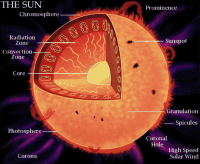 Although
the average distance from Earth to the Sun
is a whopping 149,600,000 kilometers (93,000,000
miles), careful observation from Earth reveals
a surprisingly large number of different
visible features. The most obvious and best
known feature is the Sunspot. Typically moving
in groups, these dark (in visible light),
planet-sized features have been known to
humankind for centuries. As Sunspots form
and disappear over periods of days or weeks,
they also appear to move across the Sun's
surface. Composed of strong magnetic fields,
Sunspots are shaped much like a horseshoe
magnet that rises from below the Sun's surface.
The rising hot gas is trapped by the Sunspots'
intense magnetic field that cools the Sunspots
from 6000 °C to about 4200 °C. The cool area
appears dark compared to the area around
it. Thus, from Earth, we see spots on the
Sun. In some photographs, we can also see
light colored areas around groups of Sunspots
that resemble tufts of cotton candy. We call
these fluffy looking fringes plages.
Although
the average distance from Earth to the Sun
is a whopping 149,600,000 kilometers (93,000,000
miles), careful observation from Earth reveals
a surprisingly large number of different
visible features. The most obvious and best
known feature is the Sunspot. Typically moving
in groups, these dark (in visible light),
planet-sized features have been known to
humankind for centuries. As Sunspots form
and disappear over periods of days or weeks,
they also appear to move across the Sun's
surface. Composed of strong magnetic fields,
Sunspots are shaped much like a horseshoe
magnet that rises from below the Sun's surface.
The rising hot gas is trapped by the Sunspots'
intense magnetic field that cools the Sunspots
from 6000 °C to about 4200 °C. The cool area
appears dark compared to the area around
it. Thus, from Earth, we see spots on the
Sun. In some photographs, we can also see
light colored areas around groups of Sunspots
that resemble tufts of cotton candy. We call
these fluffy looking fringes plages.
Sunspots are the source of massive releases
of energy called solar flares, the most violent
events in the solar system. In a matter of
minutes to several hours, a solar flare releases
about 10,000 times the annual energy consumption
of the U.S. Solar flares give off radiation
that includes X-rays and ultraviolet rays,
and charged particles called protons and
electrons. This sudden surge in radiation
can damage spacecraft and even give a dose
or radiation to travelers flying in airplanes
over Earth's polar regions.
One
of the most spectacular features of the
Sun are solar prominences. They appear
to stream, loop and arch away from the Sun.
The most recognizable prominences appear
as huge arching columns of gas above the
limb (edge) of the Sun. However, when prominences
are photographed on the surface of the Sun,
they appear as long, dark, threadlike objects
and are called filaments. Like Sunspots,
prominences are cooler (about 10,000 °C)
in relation to the much hotter background
of the Sun's outer atmosphere (about 1,500,000 °C).
Prominences can also erupt from the Sun with
a tremendous burst of energy.
If you have seen photographs of a solar
eclipse, then you have probably noticed
a bright halo around the Sun, called the corona.
Sometimes parts of the corona appear to
be missing. Logically, we call this area
a coronal hole. Scientists believe that
the solar wind, a million mile per hour
gale that blows away from the Sun, originates
in coronal holes. Unlike wind on Earth,
the solar wind is a stream of ionized (electrically
charged) particles speeding away from the
Sun.
The Sun's corona changes with Sunspot activity.
When there are more Sunspots, the corona
appears to be held closely to the Sun; when
there are fewer Sunspots, the corona streams
out into space in a shape that resembles
the spike on a warlike, peaked helmet called
helmet streamers. While helmet streamers
are long-lived, their demise often occurs
abruptly through a massive and powerful eruption
called a coronal mass ejection (CMEs).
These
huge clouds of hot solar gas and magnetic
field are often associated with
solar flares. They can cause magnetic storms
when they hit Earth's magnetic field and
damage electrical equipment in space and
on the ground. For example, in 1989, the
Quebec province in Canada suffered an electrical
blackout because many transformers were
destroyed by a large magnetic storm. That
one storm
caused many millions of dollars worth of
damage. A powerful solar flare erupted
from the Sun about three days before the
start
of the storm at Earth. Even when the Sun
is not too active, solar storms can cause
problems. A magnetic storm on January 11,
1997 was blamed for the loss of a $270
million dollar AT&T communications satellite.
This moderate storm was caused by a coronal
mass
ejection that erupted from the Sun even
though there were no noticeable Sunspots.

